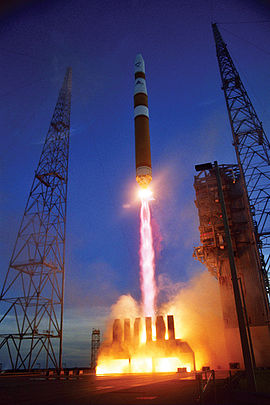Delta IV

Delta IV Medium launch carrying DSCS III-B6
|
|
| Function | Orbital launch vehicle |
|---|---|
| Manufacturer |
Boeing BDS United Launch Alliance |
| Country of origin | United States |
| Size | |
| Height | 63-72 m (206-235 ft) |
| Diameter | 5 m (16.4 ft) |
| Mass | 249,500-733,400 kg (550,000-1,616,800 lb) |
| Stages | 2 |
| Capacity | |
| Payload to LEO | 9,420-28,790 kg (20,750-63,450 lb) |
| Payload to GTO |
4,440-14,220 kg (8,500-28,620 lb) |
| Launch history | |
| Status | Active |
| Launch sites |
SLC-37B, Cape Canaveral SLC-6, Vandenberg AFB |
| Total launches |
34
|
| Successes |
33
|
| Partial failures | 1 (Heavy) |
| First flight |
|
| Last flight |
|
| Boosters (Medium+) - GEM 60 | |
| No. boosters | Medium+ (4,2), Medium+ (5,2): 2 Medium+ (5,4): 4 |
| Gross mass | 33,638 kg (74,158 lb) |
| Thrust | 826.6 kN (185,800 lbf) |
| Specific impulse | 245 s (sea level) |
| Burn time | 91 seconds |
| Fuel | HTPB |
| Boosters (Heavy) - CBC | |
| No. boosters | 2 |
| Gross mass | 226,400 kg (499,100 lb) |
| Engines | 1 RS-68A |
| Thrust | 3,140 kN (705,000 lbf) (sea level) |
| Specific impulse |
Sea level: 360 sec Vacuum: 412 sec |
| Burn time | 242 seconds |
| Fuel | LH2/LOX |
| First stage - CBC | |
| Gross mass | 226,400 kg (499,100 lb) |
| Engines | 1 RS-68A |
| Thrust | 3,140 kN (705,000 lbf) (sea level) |
| Specific impulse |
Sea level: 360 sec Vacuum: 412 sec |
| Burn time | 245 seconds (328 seconds in Heavy configuration) |
| Fuel | LH2/LOX |
| Second stage - DCSS | |
| Gross mass |
4-m: 24,170 kg (53,290 lb) 5-m: 30,700 kg (67,700 lb) |
| Engines | 1 RL10-B-2 |
| Thrust | 110 kN (25,000 lbf) |
| Specific impulse | 462 s |
| Burn time | 850-1,125 seconds |
| Fuel | LH2/LOX |
Delta IV is an expendable launch system in the Delta rocket family. The rocket's main components are designed by Boeing's Defense, Space & Security division and built in the United Launch Alliance (ULA) facility in Decatur, Alabama. Final assembly is completed at the launch site by ULA. The rockets were designed to launch payloads into orbit for the United States Air Force Evolved Expendable Launch Vehicle (EELV) program and commercial satellite business. Delta IV rockets are available in five versions: Medium, Medium+ (4,2), Medium+ (5,2), Medium+ (5,4), and Heavy, to cover a range of payload size and weight. Delta IV was primarily designed to satisfy the needs of the U.S. military.
The rockets are assembled at the Horizontal Integration Facility for launches from SLC-37B at Cape Canaveral, and in a similar facility for launches from SLC-6 at Vandenberg Air Force Base.
The Delta IV entered the space launch market when global capacity was already much higher than demand. Furthermore, as an unproven design it has had difficulty finding a market in commercial launches, and the cost to launch a Delta IV is higher than that for competing vehicles. In 2003, Boeing pulled the Delta IV from the commercial market, citing low demand and high costs. In 2005, Boeing stated that it sought to return the Delta IV to commercial service.
All of Delta IV's launches, with the exception of its debut launch carrying the Eutelsat W5 commercial communications satellite, were paid for by the US government. In 2015, ULA stated that a Delta IV Heavy is sold for nearly $400 million.
The United States Air Force (USAF) funds Delta IV engineering, integration, and infrastructure through contracts with Boeing Launch Services (BLS). On August 8, 2008 the USAF Space and Missile Systems Center increased the "cost plus award fee" contract with BLS for $1.656 billion to extend the period of performance through the end of FY09[update]. In addition a $557.1 million option was added to cover FY10.
...
Wikipedia
